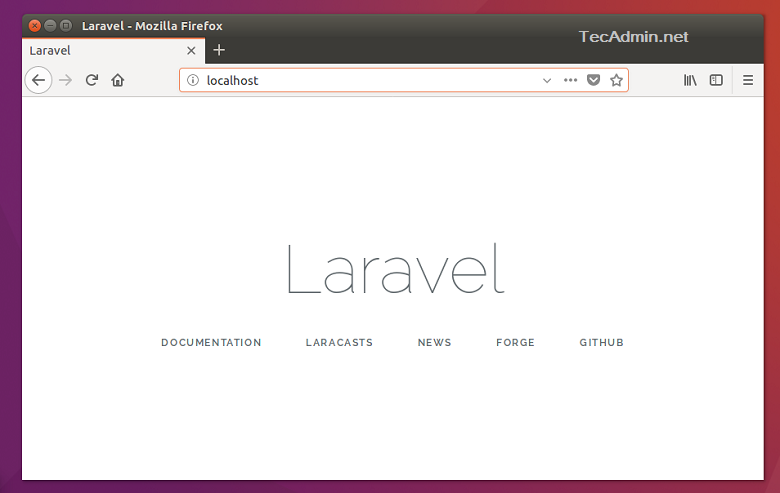How to Install Laravel PHP Framework on Ubuntu – Laravel is a flexible opensource PHP framework for web artisans. It can be used as an alternative to the CodeIgniter framework. Laravel is designed for ease of use to allow developers to create great applications.
If you’re looking for a simple and straightforward PHP framework to design your next application, you’ll find Laravel to be useful. This brief tutorial is going to show students and new users how to install the Laravel PHP framework on Ubuntu 16.04 | 17.10 | 18.04 with Apache2 and PHP 7.2 support.
Step 1 – Installing LAMP Stack
First of all, you need to setup LAMP stack on your Ubuntu system. Laravel required PHP 7.2.5 or higher version to be installed.
Install PHP
sudo apt install software-properties-common
sudo add-apt-repository ppa:ondrej/php
sudo apt install -y php7.4 php7.4-gd php7.4-mbstring php7.4-xmlApache2
sudo apt install apache2 libapache2-mod-php7.4Install MySQL
sudo apt install mysql-server php7.4-mysqlYou also need MySQL post-installation instructions.
Step 2 – Installing Composer
PHP Composer is used to installing required dependencies for the PHP application. Execute the following commands to install and configure Composer on your system.
curl -sS https://getcomposer.org/installer | php
sudo mv composer.phar /usr/local/bin/composer
sudo chmod +x /usr/local/bin/composerStep 3 – Download and Install Laravel
The latest Laravel version is available under the Github repository. Use the below command to clone the master branch of the Laravel from the GitHub repository.
cd /var/www
git clone https://github.com/laravel/laravel.gitSwitch to the Laravel directory and use the composer to install all dependencies required for the Laravel framework.
cd /var/www/laravel
sudo composer installThe dependencies installation may take some time as per your network speed. After successfully installing all dependencies, set the proper permissions on all files.
chown -R www-data.www-data /var/www/laravel
chmod -R 755 /var/www/laravel
chmod -R 777 /var/www/laravel/storageStep 4 – Create Environment Settings
Next, create the Laravel environment configuration file. You can do it by renaming the .evn.example file to .env. This will use to setup an application environment for the project.
mv .env.example .envNow generate base64 random number encryption key, which used by the Illuminate encrypter service.
php artisan key:generateApplication key set successfully.
Edit the .env configuration file and update the required settings. Also, make sure APP_KEY is properly set as generated in the above command.
vi .envAPP_NAME=Laravel APP_ENV=local APP_KEY=base64:HFdS7c9rhDp+AeHu7kc2OLBPuxHqq2BQ/1gfFWEpoAk= APP_DEBUG=true APP_URL=http://localhost ...
You can also change the APP_NAME with the name of your application and APP_URL to the URL you need to access your Laravel application.
Step 5 – Create MySQL User and Database
Next, create a MySQL database for your Laravel application. Also, create a MySQL user to connect the database from the Laravel application. Login to your MySQL server and create MySQL database and user by running following commands.
CREATE DATABASE laravel; CREATE USER ‘laravel’@‘localhost’ IDENTIFIED BY ‘secret’; GRANT ALL ON laravel.* to ‘laravel’@‘localhost’; FLUSH PRIVILEGES; quit
Now edit the .env file and update database settings.
DB_CONNECTION=mysql DB_HOST=127.0.0.1 DB_PORT=3306 DB_DATABASE=laravel DB_USERNAME=laravel DB_PASSWORD=secret
Step 6 – Apache Configuration
Next, edit Apache default virtual host configuration file (ie: 000-default.conf) and update Document Root to the Laravel public directory as below:
vim /etc/apache2/sites-enabled/000-default.confUpdate the configuration like below:
<VirtualHost *:80>
ServerAdmin webmaster@localhost
DocumentRoot /var/www/laravel/public
<Directory />
Options FollowSymLinks
AllowOverride None
</Directory>
<Directory /var/www/laravel>
AllowOverride All
</Directory>
ErrorLog ${APACHE_LOG_DIR}/error.log
CustomLog ${APACHE_LOG_DIR}/access.log combined
</VirtualHost>
Reload Apache configuration changes by restarting service using below command
sudo systemctl restart apache2Step 7 – Access Laravel Application
You have successfully configured the Laravel 7 PHP framework on your system. Access Laravel application in your favorite web browser
Let’s start building an awesome application using Laravel 7 PHP Framework. Thanks.


Leave a Reply